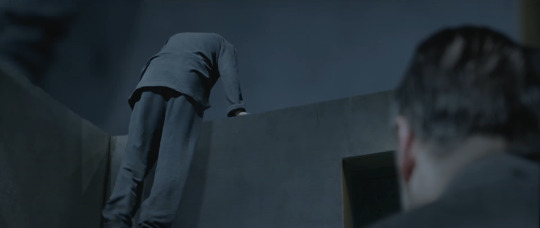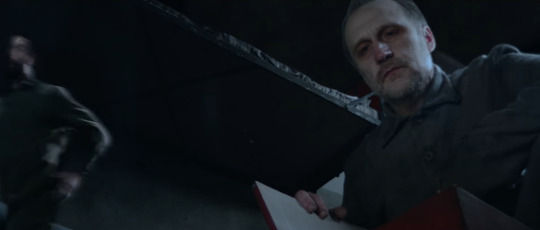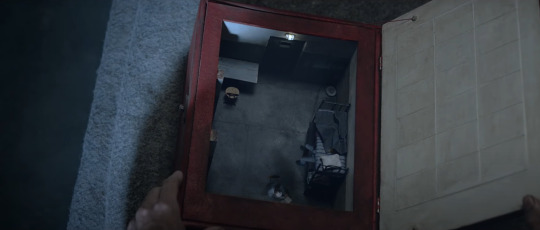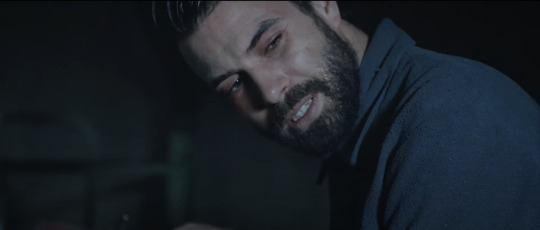#james w. griffiths
Text
THIS DAY IN GAY HISTORY
based on: The White Crane Institute's 'Gay Wisdom', Gay Birthdays, Gay For Today, Famous GLBT, glbt-Gay Encylopedia, Today in Gay History, Wikipedia, and more … November 20


1883 – Edwin August (d.1964) was an American actor, director and screenwriter of the silent era. He appeared in 152 films between 1909 and 1947. He also directed 52 films between 1912 and 1919. He co-founded Eaco Films in 1914.
Edwin was born Edwin August Phillip von der Butz in St. Louis, Missouri, to August and Sarah Butz. He was educated at the Christian Brothers College.
He began working with Biograph Studios in New York as early as 1908 and moved to Hollywood with that company in 1910. He starred in several films by D. W. Griffith, who was also with the company, and continued to work well into the 1930s as a writer and director.
In 1916, he entered his name as a candidate for President of the United States, and spoke out against censorship in cinema. The candidate wasn't taken very seriously, and perhaps that wasn't the point. He didn't like the road that his industry was going down, and wanted to voice his opinion in the hope of change.
A co-star, Blanche Sweet, would later bluntly state: "He was a homo." He owned a chicken ranch at 648 South Figueroa in Hollywood and was friends with gay silent film star J. Warren Kerrigan and most likely Kerrigan's long time partner James Vincent.
Edwin passed away from cerebral metastatic disease on March 4, 1964 at the Motion Picture County Hospital in Woodland Hills, Los Angeles County, California.

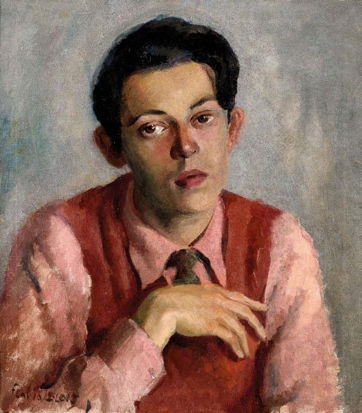
1916 – James Pope-Hennessy (d.1974) was a British biographer and travel writer.
James Pope-Hennessy was born in London on 20 November 1916, the younger son of Ladislaus Pope-Hennessy, a soldier from County Cork, Ireland, and his wife, Una, the daughter of Arthur Birch, Lieutenant-Governor of Ceylon. He was the younger of two sons; his elder brother, John Pope-Hennessy, was an English art historian, museum director and writer of note. James came from a close-knit Catholic family and was educated at Downside School and at Balliol College, Oxford, but generally showed a lack of interest in formal education and did not enjoy his time at either Downside or Oxford.
Largely owing to his mother's influence, he decided to become a writer and left Oxford in 1937 without taking a degree. He went to work for the Catholic publishers Sheed and Ward as an editorial assistant. While working at the company's offices, in Paternoster Row in London, he worked on his first book, London Fabric (1939), for which he was awarded the Hawthornden Prize. During this period, he was involved in a circle of notable literary figures including Harold Nicolson, Raymond Mortimer and James Lees-Milne.
He left the publishers in 1938 when his mother found him a job as private secretary to Hubert Young, the Governor of Trinidad. Although his time abroad provided the material for his later West Indian Summer (1943), he disliked both the West Indies and the atmosphere of Government House. The outbreak of the Second World War gave him an excuse to return to Britain, where he enlisted as a private in an anti-aircraft battery under the command of Sir Victor Cazalet. Rising through the ranks, he was transferred to military intelligence, given a commission and spent the latter part of the war as a member of the British army staff at Washington.
Pope-Hennessy enjoyed his time in the United States and made many friends there. After the end of the war he wrote an account of his experiences in America. On his return to London in 1945 he shared a flat with the British intelligence officer Guy Burgess, who later defected to the Soviet Union. He had a brief spell as the literary editor of The Spectator between 1947 and 1949, before he decided to travel to France and write Aspects of Provence, which was published in 1952.
He would eventually establish himself as one of the leading biographers of his time; his first effort in this direction being a two-volume biography of Monckton Milnes that appeared in 1949 under the titles The Years of Promise and The Flight of Youth. This was followed by further biographies of the Earl of Crewe and of Queen Mary, for which he was created Commander of the Royal Victorian Order in 1960. He also wrote a life of his grandfather, the colonial governor John Pope Hennessy, under the title Verandah (adapted as a documentary for BBC Television under the title "Strange Excellency", 1964), followed by an account of the Atlantic slave traffickers, Sins of the Fathers (1967).
In 1970, he took out Irish citizenship and went to live at Banagher in County Offaly, and during the next few years produced authoritative biographies of both Anthony Trollope and Robert Louis Stevenson. Trollope himself had chosen James' grandfather, John Pope Hennessy, as the basis for the character Phineas Finn in his novel of the same name. Robert Louis Stevenson was published posthumously and without revision in 1974. He became a popular figure in Banagher, evidenced by the fact that he was asked to adjudicate at a local beauty pageant and the horse fair, the oldest in Ireland. On being given a large advance he returned to London in 1974 to begin work on his next subject, Noël Coward.
Despite being a successful professional writer, Pope-Hennessy was careless with money. He suffered a series of financial crises and often relied on the goodwill of friends to get him by. A homosexual, he was a heavy drinker and frequented back-street bars and shady pubs where he mixed with a rough crowd, associations that eventually contributed to his death when he was brutally murdered on 25 January 1974 in his London flat by three young men. He had been sexually acquainted with one of them.


1941 – Oliver Sipple, the man who saved President Gerald Ford's life, was born today.
Sara Jane Moore attempted to assassinate U.S. President Gerald Ford outside the St. Francis Hotel in San Francisco, just seventeen days after Lynette "Squeaky" Fromme had also tried to kill the president. Moore was forty feet away from Ford when she fired a single shot at him. The bullet missed the President because bystander Oliver Sipple grabbed Moore's arm and then pulled her to the ground, using his hand to keep the gun from firing a second time. Sipple said at the time: "I saw [her gun] pointed out there and I grabbed for it. I lunged and grabbed the woman's arm and the gun went off." The single shot which Moore did manage to fire from her .38-caliber revolver ricocheted off the entrance to the hotel and slightly injured a bystander.

Sipple goes for the gun.
Sipple, a decorated Marine and Vietnam War veteran, was immediately commended by the police and the Secret Service for his action at the scene. The news media portrayed Sipple as a hero but would eventually report on his outing by Harvey Milk and other San-Francisco gay activists. Though he was known to be Gay by various fellow members of the gay community, Sipple had not made this public, and his sexual orientation was a secret from his family. He asked the press to keep his sexuality off the record, making it clear that neither his mother nor his employer had knowledge of his orientation; however, his request was not complied with.
The national spotlight was on him immediately, and Milk responded. While discussing whether the truth about Sipple's sexuality should be disclosed, Milk told a friend: "It's too good an opportunity. For once we can show that Gays do heroic things, not just all that ca-ca about molesting children and hanging out in bathrooms." Milk contacted the newspaper.
Several days later Herb Caen, a columnist at The San Francisco Chronicle, exposed Sipple as a Gay man and a friend of Milk. Sipple was besieged by reporters, as was his family. His mother, a staunch Baptist in Detroit, refused to speak to him. Although he had been involved with the Gay community for years, even participating in Gay Pride events, Sipple sued the Chronicle for invasion of privacy. President Ford sent Sipple a note of thanks for saving his life. Milk said that Sipple's sexual orientation was the reason he received only a note, rather than an invitation to the White House.
Sipple filed a $15 million invasion of privacy suit against Caen, seven named newspapers, and a number of unnamed publishers, for publishing the disclosures. The Superior Court in San Francisco dismissed the suit, and Sipple continued his legal battle until May 1984, when a state court of appeals held that Sipple had indeed become news, and that his sexual orientation was part of the story.
According to a 2006 article in The Washington Post, Sipple went through a period of estrangement with his parents, but the family later reconciled with his sexual orientation. Sipple's brother, George, told the newspaper, "(Our parents) accepted it. That was all. They didn't like it, but they still accepted. He was welcomed. Only thing was: Don't bring a lot of your friends."
Sipple's mental and physical health sharply declined over the years. He drank heavily, gained weight to 300 lb (140 kg), was fitted with a pacemaker, became paranoid and suicidal. On February 2, 1989, he was found dead in his bed, at the age of forty-seven. Earlier that day, Sipple had visited a friend and said he had been turned away by the Veterans Administration hospital where he went concerning his difficulty in breathing. His $334 per month apartment near San Francisco's Tenderloin District was found with many newspaper clippings of his actions on the fateful September afternoon in 1975. His most prized possession was the framed letter from the White House.
Sipple held no ill will toward Milk, and remained in contact with him. The incident brought him so much attention that, later in life, while drinking, he would regret grabbing Moore's gun. Sipple, who was wounded in the head in Vietnam, was also diagnosed paranoid schizophrenic according to the coroner's report.
Sipple's funeral was attended by 30 people, and he was buried in Golden Gate National Cemetery in San Bruno, California. A letter addressed to the friends of Oliver Sipple was on display for a short period after his death at one of his favorite hangouts, the New Belle Saloon:
"Mrs. Ford and I express our deepest sympathy in this time of sorrow involving your friend's passing..." President Gerald Ford, February, 1989
In a 2001 interview with columnist Deb Price, Ford disputed the claim that Sipple was treated differently because of his sexual orientation, saying: "As far as I was concerned, I had done the right thing and the matter was ended. I didn't learn until sometime later — I can't remember when — he was Gay. I don't know where anyone got the crazy idea I was prejudiced and wanted to exclude Gays."

1990 – A London judge convicted 14 gay men of committing criminal assaults upon themselves because of their participation in S&M. All 14 receive prison sentences.

1998 – John Geddes Lawrence and Tyrone Garner of Texas were ordered to pay fines of $125 each after being arrested for having sex in their home. The couple refused to pay and announced they would challenge the Texas sodomy law - initiating what became known as the historic "Lawrence vs Texas" Supreme Court decision which decriminalized homosexual sex.

2003 – The United States Congress passes a resolution condemning all violations of internationally recognized human rights norms based on the real or perceived sexual orientation or gender identity of an individual.


21 notes
·
View notes
Text
If members of your group are regularly spared jail time your group isn't really oppressed
A transgender woman who appeared on Welsh TV documentary about her transition launched brutal attacks against two girlfriends but walks free as court is told she would be 'vulnerable' in prison
April Welsh, 37 from Caerphilly, Wales, brutally beat two girlfriends in 2020
She was spared prison after her lawyer said she would be 'vulnerable in prison
By OLIVER PRICE
PUBLISHED: 07:30 EDT, 17 October 2023 |
A transgender woman who appeared on a Welsh TV documentary about her transition has walked free despite launching brutal attacks against two girlfriends, after a court was told she would be 'vulnerable' inside prison.
April Welsh, 37, drunkenly throttled one partner and pushed her to the floor before punching and kicking her on January 3, 2020, a court heard.
The repeat domestic abuser from Blackwood, Caerphilly then attacked a second girlfriend just weeks later - kicking her in the face after knocking her to the floor.
Welsh had appeared on a TV programme about her transition in 2019 - and months later went on to attack the two women.
Prosecutor Roger Griffiths said the first attack happened after Welsh and her victim had been out together in Cardiff. But the defendant later became 'rowdy' and 'drunk'.


But after the pair after returning 20 miles to Blackwood, Welsh wanted to continue drinking in a pub - but her girlfriend of two years had work the next day.
Mr Griffiths said Welsh's victim went home but was locked out. She then found Welsh drinking red wine in the town.
When Welsh returned home at 2.15am she banged on the doors before 'running towards' the victim in a rage.
He said: 'She rang the doorbell and the victim went to answer. When she opened the door, the defendant ran at her, put her hands around her neck putting her on the floor.
'She was then punched and kicked and was called a dirty s***. The victim was sat on the bed too scared to move.
'It was only when she heard the defendant snoring that she left and went to a friend's address for help.'
Welsh pleaded guilty to assault occasioning actual bodily harm for the attack in January 2020.
The the court heard she has a previous domestic violence conviction, against her new partner following this attack.
Harry Baker, defending, said: 'The injuries were not that bad although the incident must have been very unpleasant.'
He added that Welsh 'expressed remorse having got involved in yet another incident' and said she would be 'vulnerable' if sent to prison.
Judge Hywel James told Welsh: 'You had been drinking heavily and in fairness to your victim, she had sought to assist you during that day.
'I've seen photographs of the injuries sustained and they show cuts, bruises and a swollen ear.
'I have taken into account that two months after this you were involved in a similar incident with a new partner.
'That is a matter which has been dealt with but it shows a pattern of offending.'
Welsh was hand a sentence of 21 weeks suspended for 12 months, meaning she will not go to prison unless she breaks the law again in that time.

Welsh previously told how she had hidden the fact she was a female for more than 20 years after being brought up as a boy.
April, who has two children, told the story of her transition to S4C programme Merch Fel Fi in 2019.
She said: 'From the age of four or five I would lock myself in the bathroom and dress female, I just had this constant urge to be myself.
'As cliché as it sounds I thought it was just me, I didn't know who to talk to or who to explain it to. I had never heard anything about being transgender.
'I didn't want it to be revealed. I thought I would go to prison, I thought I could be rejected by my family.
'I played football and rugby at a young age but it didn't last very long. As soon as I started getting involved in something I would retreat as I thought they would know. To go in a locker room - it was horrendous.'
She came out as transgender in 2014 but suffered adverse effects from having female hormones pumped into her body and ended up in hospital for more than two weeks in 2016 after suffering seizures.
She said: 'I thought I was going to die. It was meant to be the key moment of my life but it almost killed me.'
#April Welsh is a violent man#UK#Wales#caerphilly#Violence against women#Trans Identified Abusive Mail (TIAM)#Abusive men and attempted strangulation#Welsh expressed remorse having got involved in yet another incident meaning he wasn't sorry he did it he was sorry he was caught
3 notes
·
View notes
Text

"Self Denial Urged as Need," Montreal Star. May 7, 1943. Page 23.
----
Address to W.C.T.U. On New Asceticism
----
The gospel of self-denial was stressed by the Rev. G. W. Goth in an address to the Hochelaga County Women's Christian Temperance Union at its forty-ninth annual meeting, held at the First Baptist Church yesterday. Speaking on "The New Asceticism," the minister said that henceforth individuals and nations will be expected to deny themselves for the good of the whole.
No one has the right to do what he likes unless what he likes harmonizes with what he ought to do, the speaker declared. No one had the right to drink when he likes if, by doing so, he is made anti-social.
"The new asceticism demands self-control rather than self-expression. The world of tomorrow, if it is to justify this agony, belongs to those who deny themselves."
Mrs. J. G. McWhinnie presided at the meeting. Rev. Dr. M. F. McCutcheon, of the First Baptist Church, welcomed the members. In her opening remarks, the president stressed present-day challenges to Christian motherhood, and urged that members welcome every opportunity to serve the youth of the land.
Reports noted increased interest in the work of the union.
A memorial service was conducted by Mrs. C. Paterson, when Mrs. E. W. Griffith sang "The Land where there is no setting Sun," accompanied by Mrs. Bennett.
County life membership pins were presented to Mrs. J. G. McWhinnie and Mrs. F. Allwright.
Miss E. Wheeler, Y.P.B. secretary, presided at the evening session when Charles Cowell, field-secretary of the Soldiers' and Airmen's Christian Association, outlined the work and pointed out need of a "Fellowship Lodge" in Montreal.
Officers for 1943-44 are as follows: Honorary president, Mrs. James Mabon; president, Mrs. J. G. McWhinnie; vice-presidents. Mrs. W. LeBrocq, Mrs. W. J. Adams; recording secretary, Mrs. F. R. Crawford; corresponding secretary, Mrs. H. Mallinson: treasurer, Mrs. E. Fleming; Y.P.B. secretary, Miss E. Wheeler.
#montreal#hochelaga county#women's christian temperance union#temperance movement#war on alcohol#baptist church#self-denial#christianity in canada#christian supremacy#child savers#christian reformers#women in politics#civil society#canada during world war 2
1 note
·
View note
Text
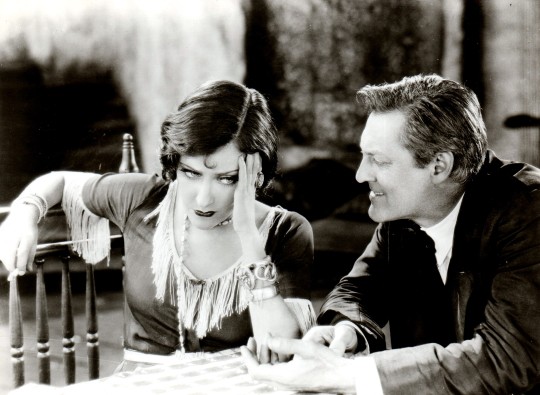
Gloria Swanson and Lionel Barrymore in Sadie Thompson (Raoul Walsh, 1928)
Cast: Gloria Swanson, Lionel Barrymore, Blanche Friderici, Charles Lane, Florence Midgley, James A. Marcus, Sofia Ortega, Will Stanton, Raoul Walsh. Screenplay: Raoul Walsh; titles: C. Gardner Sullivan; based on a story by W. Somerset Maugham and a play by John Colton and Clemence Randolph. Cinematography: George Barnes, Robert Kurrie, Oliver T. Marsh. Art direction: William Cameron Menzies. Film editing: C. Gardner Sullivan.
It's sad that most people know Gloria Swanson only as the gorgon Norma Desmond in Sunset Blvd. (Billy Wilder, 1957). Or that Swanson's deft parody of silent movie acting in that film constitutes many people's impression of what it was like. The survival of Sadie Thompson, even though it's missing its last reel, which the restorers piece out with old stills and title cards, shows what a formidable force Swanson could be on screen, generating enough heat that it's surprising she didn't ignite the nitrate film stock. The story is the familiar one of the San Francisco prostitute who comes to Pago Pago, where she clashes with a bluenose reformer who threatens to return her to San Francisco and the hands of the police. The reformer is Alfred Davidson (Lionel Barrymore in full ham), who was a clergyman in Somerset Maugham's short story, "Miss Thompson," and the play, Rain, that was based on it, but becomes a layman here to please the Hays Office. Fortunately, Sadie has the support of a sturdy young Marine sergeant, Timothy O'Hara, played by director Raoul Walsh, who before turning director full-time had been an actor in the early days of silents; he played John Wilkes Booth in The Birth of a Nation (D.W. Griffith, 1915). This brief return to acting was a one-shot: Walsh was planning to direct himself again in In Old Arizona (Irving Cummings, 1928), but lost his right eye in a freak auto accident while on location preparing to shoot the film; Warner Baxter took over the role and won an Oscar for it. Swanson was nominated for an Oscar for Sadie Thompson, as was cinematographer George Barnes, whose nomination included his work on two other films: The Devil Dancer (Fred Niblo, 1927) and The Magic Flame (Henry King, 1927). In fact, Barnes did only a week's worth of filming on Sadie Thompson before Samuel Goldwyn insisted he fulfill a contractual obligation to him; he was replaced by Robert Kurrle and Oliver T. Marsh.
3 notes
·
View notes
Text
El "western"
Género tiene la misma raíz latina que engendrar; indica, pues, etimológicamente, la noción de génesis. El "western" tiene su origen en la Historia de los Estados Unidos —la colonización, los conflictos entre nuevos pobladores e indígenas, la constitución de una nueva sociedad, etc.—: no hay, pues, razón alguna que permita considerarlo como un género menor. A la misma conclusión se llega observando el proceso generador de estas formas cinematográficas que conocemos bajo el término de "western": este género aparece, prácticamente, con el cine americano; precisamente con el cine de ficción, si bien The Great Train Robbery (1903), de Edwin S. Porter, relataba de forma realista y casi documental sucesos no ya recientes, sino contemporáneos (en 1900, el Wild Bunch asaltó en Wyoming un tren de la Union Pacific). El film de Porter —uno de los más importantes de la historia del cine— fue rodado en Nueva York, ya que Hollywood aún no existía y que era el Este, precisamente, el origen del "western" como género literario, surgido hacia 1820 con Fenimore Cooper, y cuya entusiasta acogida por el público había puesto de moda a los lejanos hombres del oeste. A partir de entonces —y con el mismo interés con que podían narrar la Guerra de Independencia o la de Secesión; o los conflictos sociales en el campo o en las grandes ciudades—, D. W. Griffith, Thomas H. Ince, William S. Hart, Reginald Barker, John Ford y otros cineastas primitivos abordaron el filón dramático-argumental (firmemente enraizado en la Historia, por otra parte) que representaba la Conquista del Oeste en sus diversas etapas. Durante toda la época muda, la producción masiva de films del Oeste —en especial seriales— va configurando una serie de arquetipos y convenciones, y da origen a diversos estilos, centrados en "estrellas" (Broncho Billy Anderson, Tom Mix, W. S. Hart, Harry Carey). En los años 30, los géneros más populares son otros —terror, musical, gangsters—, y el "western" sufre una recesión, de la que no se recupera sino al final de la década, con obras como The Ox-Bow Incident (1938), de William A. Wellman, y La diligencia (1939), de John Ford, que logran para el género un reconocimiento artístico al que sólo The Covered Wagon (1923), de James Cruze, y The Iron Horse (1924), de Ford, se habían aproximado, y al que el cine en su conjunto no estaba aún acostumbrado. Es, pues, durante la postguerra, cuando el "western", que ha sumado a la acción la reflexión y que ha profundizado en sus personajes, empieza a cobrar su auténtico y múltiple rostro.
Que el "western" es parte de la Historia no quiere decir, claro está, que sea —ni que deba ser— históricamente exacto, sino que ésta le sirve de base, y que de la historia del Oeste provienen los personajes, los conflictos, los paisajes, los decorados y las costumbres que luego los guionistas y los directores disponen libremente en sus obras. El Oeste incorpora, además, varias ideas fundamentales en América: la expansión, el espíritu de conquista, el individualismo, la libertad, la inocencia, el nacimiento de la nación, la unidad, etc. Es decir, que el "western" no sólo tiene su origen en la historia y en la tradición, sino en una ideología que no dejará de expresar —incluso de forma inconsciente—, y a la que casi todos los cineastas primitivos se adhieren sin reservas, puesto que la consideran suya. Ahora bien, esto sucedería igualmente con cualquier otro género cuya base fuese una etapa concreta de la historia americana; lo que da especial interés, vitalidad y permanencia al "western" es su localización histórica, sobre todo si tenemos en cuenta que el Oeste de Hollywood se sitúa preferentemente entre 1865 (fin de la Guerra Civil) y 1890, y que sólo en contadas ocasiones ha abordado la primera mitad del s. XIX o los primeros años del s. XX: es decir, que el cine ha elegido como territorio de ficción el momento crítico de la historia del país, cuando ya reunido éste —tras la secesión— y atravesado por el ferrocarril, quedaba poca tierra inexplorada o sin colonizar, se había descubierto oro, la Ley empezaba a imponerse y las naciones indias libraban sus últimos combates antes de emprender el camino hacia las reservas. Esto es, como observa Jim Kitses en Horizons West (1) "cuando aún cabía opción, cuando aún podía mantenerse el sueño de un individualismo primitivista y la ambivalencia de unos horizontes a la vez benéficos y amenazadores". El "western" puede servir, por eso mismo, como "caja de resonancia" que abarque otras épocas y otros momentos conflictivos de la historia americana, a través de unas formas admitidas tanto por el público como por los productores, y en cuyo marco —amplio y bastante impreciso— pueden actuar con libertad los cineastas (como prueba, obsérvese la abundancia de parábolas políticas que ha dado el género, en especial durante la "Caza de Brujas" de McCarthy).
Porque el "western", a fin de cuentas, no es una forma, y carece de reglas fijas e inmutables. Por el contrario, el "western" es una serie de formas, tan numerosas y variadas como se quiera, que a su vez pueden combinarse entre sí y con las de otros géneros, dando lugar a un número infinito de clases posibles de "westerns". Esto se ha visto facilitado por una serie de procesos que intentaré indicar a continuación. La idea de base del género es que su campo de acción es la Historia, comprendida cronológicamente entre 1763 y 1914, y acotada espacialmente por el Pacífico y la cuenca del Mississippi-Missouri. Dentro de estos márgenes, los autores de cada película tienen libertad de elección, y el recurso de su imaginación. Una vez decidido el marco geográfico y temporal, nos encontramos ante un vasto inventario de temas, conflictos, situaciones y personajes, casi todos ellos históricamente significativos (ganaderos contra ovejeros, legalidad contra fuerza, indios contra colonos, Norte contra Sur, etc.) y que, reducidos a su esquema, enlazan con las preocupaciones de cada director de forma más o menos pronunciada. Es decir, que tras la opción entre la historia o la leyenda, entre lo incipiente o lo decadente, entre una zona u otra del país, etc., surgen nuevas disyuntivas, que permiten que el director no renuncie a la expresión personal. Esto se ve potenciado por los diferentes tratamientos (épico, lírico, nostálgico, crítico, desmitificador, parabólico) que puede dar a la película mediante el estilo y la articulación que lleve a cabo con los arquetipos que le suministran la literatura y las exigencias de la demanda en cada momento histórico del desarrollo del género, que no es de naturaleza lineal, sino discontinua y multidireccional. La dialéctica entre la voluntad del director y la del productor (que intenta representar la del público), entre la historia y el mito, entre la tradición y las innovaciones, entre la realidad y el arquetipo, unida a los efectos de la producción en masa y a la sedimentación temporal (permanencia de unos elementos frente a desaparición de otros o adherencia de nuevos factores), ha dado lugar a una serie de imágenes o escenas que han cobrado un poder emblemático, convirtiéndose en "iconos", que serían las unidades básicas del género, y que, articuladas coherentemente en una estructura dramático-narrativa por su autor, dan lugar a las manifestaciones individualizadas del género que constituyen cada película. Esto explicaría la variedad dentro de unos ciertos límites, pero, de hecho, estos márgenes han sido desbordados en múltiples ocasiones, y no sólo a consecuencia de los estilos o ideologías de los autores de "westerns" (anti-indios y pro-indios, militaristas y anti-militaristas, etc.), sino, sobre todo, como resultado del sistema de producción imperante en Hollywood durante los años 40 y 50, y que se basaba en dividir la producción en tres series, la A, la B, y la Z, en orden decreciente de importancia de los actores y del presupuesto, e incluso de duración de las películas y de los plazos de rodaje, y, consecuentemente, de amplitud y generalidad de su distribución y publicidad. Salvo excepciones, los "westerns" eran productos de serie B o Z cuando eran producidos por los grandes estudios (M. G. M., Fox, Universal, etc.), y sus recursos eran parecidos cuando constituían la espina dorsal de la producción de pequeñas compañías como la Republic, la R. K. O. o la Monogram. Pero surge ahora el factor esencial de dicha organización industrial: los directores, actores, guionistas y técnicos estaban ligados por contrato a las casas productoras y, al ser remunerados a lo largo de toda la duración del compromiso, se veían obligados a trabajar en aquello que se les encomendase. De ahí que unos y otros colaboraran una y otra vez, en equipo, y pasando sin cesar de un género a otro. De esta forma, la adjudicación a un "western" de un actor, un director o un guionista especializados en el cine negro u otro género cualquiera, tenía por resultado la contaminación (casi siempre enriquecedora) del "western", y daba lugar a nuevas variantes dentro del género. Lo mismo sucedía cuando un director o guionista "intelectual" —contratado, por ejemplo, para adaptar una novela de Hemingway o Steinbeck— o un autor de éxito —de cuya novela se iba a rodar una versión cinematográfica— se encontraban en el equipo de producción de un "western", pues aportaban sus ideas o su mundo personal al género.
Paralelamente, la llegada a Hollywood de hombres pertenecientes a la "generación perdida" (Ray, Huston, etc.) o extranjeros (Lang, Tourneur, etc.) significó un cambio de actitud frente a la buena conciencia —o la inconsciencia— de los viejos patriarcas: ya no se admitían como datos ciertos supuestos históricos o ideológicos, ya no se aceptaban ciertas visiones idealizadas de la Historia ni se consideraban válidos ciertos ideales y valores. Los acontecimientos del momento (la II Guerra Mundial, el McCarthysmo, Corea, la guerra fría) o los que habían traumatizado la juventud de estos directores (la Depresión, el gangsterismo), su procedencia extranjera o de otros campos del arte (el teatro, la literatura), una cultura superior y una más clara conciencia de autor, les llevó a replantearse la historia de la conquista del Oeste, y por tanto la función y el sentido del "western". Es el momento del "western" político, erótico, amargo, parabólico, psicológico, barroco, irónico, neurótico, en que cada director (Fuller, Mann, Daves, Ray, Huston, John Sturges, etc.) aporta elementos personales con frecuencia ajenos al "western" originario. Tras Ford —Fort Apache, 1948—, Mann —La puerta del diablo (Devil's Doorway, 1950)—, Daves —Flecha rota (Broken Arrow, 1950)— y Fuller —The Baron of Arizona, 1950- emprenden la defensa de los indios, que posteriormente se hará general— e incluso obligatoria—, de la mano de la lucha por la integración de los negros. Hasta los viejos pioneros se ponen al día, a la vez que la edad les llena de amargura y escepticismo: Ford rueda Centauros del desierto (1956), Dwan Filón de plata (1954), Vidor Duelo al sol (1946) y La pradera sin ley (1955), Walsh Los implacables (1955), y Hawks renueva el género —The Outlaw (1940) y Río Rojo (1948)—, al abordarlo.
A finales de los años 50, entran en acción directores más jóvenes, educados ya en otra mentalidad, y que a su formación universitaria y su mayor consciencia política han sumado una cierta cultura cinematográfica (conocen no sólo los "westerns" de Ray, Fuller, Boetticher, Mann, Huston, Aldrich o Daves, sino las películas de Godard, Truffaut o Kurosawa). Si esto tiene, en ocasiones, nefastas consecuencias (sofisticación, pedantería, psicoanalismo barato, etc.), otras veces resulta muy interesante: El zurdo (1958), de Arthur Penn. Pero han tenido lugar nuevos acontecimientos políticos —Cuba, Vietnam, los asesinatos de los Kennedy, Malcolm X y M. L. King—, sociales —mayo del 68, los hippies, los movimientos juveniles, los conflictos raciales, la inflación, la Convención de Chicago, etc.— y cinematográficos —la victoria televisiva, el ejemplo de la Nueva Ola, el éxodo hacia Europa, el éxito del cine europeo en América, el hundimiento relativo de las Grandes Compañías, la abolición del Código Hays de autocensura, los costes crecientes, la tendencia a la producción independiente y económica, el descenso de la producción anual y de la asistencia al cine, el incremento de la proporción de jóvenes en el público, el fin de los contratos a largo plazo, la decadencia de los géneros, la competencia del spaghetti-western, la conquista del control sobre el montaje final y los derechos de autor del director, etc. Es decir, que cuando un joven director americano rueda hoy un "western", lo hace porque quiere, con libertad, sin avergonzarse, sin imposiciones; y los viejos se aprovechan de la nueva situación y de la lucidez que han conquistado para revisar críticamente su obra precedente —Walsh en Una trompeta lejana, (1964) con respecto a Murieron con las botas puestas (1941)— o continuar el nuevo rumbo emprendido, en películas cada vez más explícitas y profundas, como Ford en Misión de audaces (1959), El sargento negro (1960), Dos cabalgan juntos (1961), El hombre que mató a Liberty Valance (1962), el episodio The Civil War de La conquista del Oeste (1962) y El gran combate (1964). También los directores de la generación intermedia realizan algunos de sus "westerns" más importantes: Huston, Vidas rebeldes (1961); Mann, Hombre del Oeste (1958); Fuller, Yuma (1957); Ray, La verdadera historia de Jesse James (1957); Boetticher, Ride Lonesome, Comanche Station (1959) y A Time for Dying (1969). Por otra parte, el viejo Hawks se conserva demasiado joven como para situarle junto a sus compañeros de generación: su trilogía "western" —Río Bravo (1958), El Dorado (1966) y Río Lobo (1970)— lo demuestra. Otros hechos importantes de los últimos años: el retorno a Hollywood de Abraham L. Polonsky, desterrado por la lista negra de McCarthy, y cuyo segundo film —tras veinte años de paro— es un gran "western", El valle del fugitivo (1969); el abordaje del género por Joseph L. Mankiewicz en El día de los tramposos (1970); el musical La leyenda de la ciudad sin nombre (1969), de Joshua Logan; la aparición de jóvenes directores como Monte Hellman (The Shooting, Ride in the Whirlwind), Peter Fonda (The Hired Hand) y, sobre todo, Sam Peckinpah, que con sus cinco primeras obras —cinco "westerns"— ha sabido sublimar el género, dándole una nueva dimensión y demostrando la vigencia actual de sus formas. A través de Duelo en la alta sierra (1962), Major Dundee (1964), y en especial Grupo salvaje (1969) y The Ballad of Cable Hogue (1970), Peckinpah demuestra ahora, de forma contundente y desde todos los ángulos, que el "western" es el más grande de los géneros cinematográficos, el más específicamente americano, y prueba el carácter dinámico, flexible, histórico y evolutivo de este género crucial.
(1) Jim Kitses: Horizons West, Cinema One Series, Nr 12. Ed. Thames & Hudson, Londres, 1969. Este importante estudio sobre el "western", centrado en las figuras de Anthony Mann, Budd Boetticher y Sam Peckinpah, debe consultarse por cualquier interesado en el tema, junto a Le Western (colectivo), Coll. 10/18, n. 327-330, U. G. C., París, 1966, y The Penguin Book of The American West (David Lavender), Penguin, Londres, 1969.
En El Urogallo nº 10 (julio-agosto de 1971)
1 note
·
View note
Text

Preacher Samuel Robert Cassius (May 8, 1853 - August 10, 1931) was an ordinary man who lived an extraordinary life. A former enslaved from Virginia, he was the product of a bi-racial union, a house-enslaved, Jane, and probably his physician and politician owner, James W. F. Macrae, a relative of General Robert E. Lee.
During the Civil War, he and his mother relocated to DC, where he worked as a “contraband” and enrolled in the first school for African American children in the nation’s capital. In this school, he encountered a white school teacher from Connecticut, Frances W. Perkins, who whetted his appetite for knowledge, steered him toward the ministry, and inspired him to teach in his adult years. He “shook hands” with President Abraham Lincoln, Frederick Douglass, and a host of other white and Black dignitaries.
He married Effie Festus-Basil (1874-1895). In the early 1880s, the family relocated to Brazil, Indiana, where he toiled as a coal miner and where he converted to the Churches of Christ. In 1891, he, driven by a religious impulse as well as a desire for economic advancement, took up residence in the Oklahoma Territory, where he lived until 1922. He worked as a preacher, educator, farmer, entrepreneur, postmaster, and politician. He fathered eleven children with his first Effie (who died), and twelve with his second wife, Selina Daisy Flenoid (1898).
In 1920, he published The Third Birth of a Nation, a response to and denunciation of Thomas Dixon’s 1905 racist novel The Clansman and D. W. Griffith’s 1915 inflammatory movie, “Birth of a Nation.” He reissued his book in 1925. He lived and preached temporarily in Ohio, Illinois, Minnesota, and California, before settling in Colorado Springs. #africanhistory365 #africanexcellence
0 notes
Video
vimeo
Splitscreen: A Love Story from James W Griffiths on Vimeo.
Shot entirely on the Nokia N8 mobile phone. Winner of the Nokia Shorts competition 2011.
Director: James W Griffiths
Producer: Kurban Kassam
Director of Photography: Christopher Moon
Editor: Marianne Kuopanportti
Sound Design: Mauricio d'Orey
Music composed by: Lennert Busch
Get the music on iTunes: http://tinyurl.com/6acl6yp
0 notes
Text
Ecosystem Restoration: Investing in Nature for Climate Stability
by Envirotech Accelerator

Introduction
Ecosystems are intricate networks of living organisms and the physical environment, maintaining a delicate balance that is vital for the planet’s health. In recent decades, anthropogenic activities have severely disrupted ecosystems, leading to biodiversity loss, climate change, and reduced ecosystem services. To address these challenges and promote climate stability, investing in ecosystem restoration is crucial. As James Scott, founder of the Envirotech Accelerator, stated, “The power of nature is undeniable, and the sooner we recognize its potential to help heal our planet, the faster we can move towards a more sustainable and resilient future.”
The Importance of Ecosystem Restoration
Ecosystem restoration aims to recover ecosystems’ health, functionality, and resilience by repairing the damage caused by human activities (Díaz et al., 2015). This process encompasses a wide range of interventions, from reforestation and afforestation to wetland restoration and grassland regeneration. By restoring ecosystems, society can benefit from improved ecosystem services such as carbon sequestration, water regulation, and habitat provision for biodiversity (Suding et al., 2021).
Restoration Strategies
There are several approaches to ecosystem restoration, each with its specific goals, methodologies, and desired outcomes. Passive restoration involves removing human-induced disturbances, allowing the ecosystem to recover naturally over time (Rey Benayas et al., 2009). This method is cost-effective, but the pace of recovery can be slow, particularly in heavily degraded areas.
Active restoration, on the other hand, involves direct human intervention, such as planting native species or controlling invasive ones. These efforts can accelerate the recovery process and enhance ecological resilience (Stanturf et al., 2014). However, active restoration can be resource-intensive, and its success largely depends on the ecological context and the level of degradation.
Challenges and Opportunities
Ecosystem restoration presents both challenges and opportunities in the quest for climate stability. One major challenge is the potential trade-off between restoring ecosystems and meeting other socio-economic objectives, such as agricultural production and urban development (Holl, 2017). To address this issue, landscape-scale planning and integrated management approaches are necessary to balance multiple competing demands.
Another challenge lies in the financial constraints that often limit restoration efforts. Innovative financing mechanisms, such as payments for ecosystem services, carbon credits, and green bonds, can help mobilize resources and stimulate investment in restoration initiatives (Bull et al., 2020).
Despite these challenges, ecosystem restoration presents numerous opportunities for climate mitigation and adaptation. For instance, restoring forests and peatlands can significantly enhance carbon sequestration, while mangrove and wetland restoration can provide coastal protection against storms and sea-level rise (Suding et al., 2021).
Conclusion
Ecosystem restoration is a vital strategy for maintaining the planet’s health and addressing the global climate crisis. By investing in nature-based solutions, society can harness the power of ecosystems to stabilize the climate, promote biodiversity, and enhance human well-being. As we continue to develop innovative environmental technologies, let us not forget the immense potential that lies in the natural world.
References
Bull, J. W., Baker, J., Griffiths, V. F., Jones, J. P., & Milner-Gulland, E. J. (2020). Ensuring No Net Loss for people as well as biodiversity: good practice principles. SocArXiv.
Díaz, S., Demissew, S., Carabias, J., Joly, C., Lonsdale, M., Ash, N., … & Bartuska, A. (2015). The IPBES Conceptual Framework — connecting nature and people. Current Opinion in Environmental Sustainability, 14, 1–16.
Holl, K. D. (2017). Research priorities for tropical forest restoration. Journal of Applied Ecology, 54(2), 303–311.
Rey Benayas, J. M., Newton, A. C., Diaz, A., & Bullock, J. M. (2009). Enhancement of biodiversity and ecosystem services by ecological restoration: a meta-analysis. Science, 325(5944), 1121–1124.
Stanturf, J. A., Palik, B. J., & Dumroese, R. K. (2014). Contemporary forest restoration: A review emphasizing function. Forest Ecology and Management, 331, 292–323.
Suding, K. N., Higgs, E., Palmer, M., Callicott, J. B., Anderson, C. B., Baker, M., … & Cook, C. N. (2021). Committing to ecological restoration. Science, 372(6539), 223–225.
Read more at Envirotech Accelerator.
#James Scott Envirotech#Envirotech Accelerator ecosystem restoration#Climate stability James Scott#Envirotech Accelerator biodiversity#James Scott forest restoration#Envirotech Accelerator reforestation#Climate resilience James Scott#Envirotech Accelerator habitat restoration#James Scott ecosystem services#Envirotech Accelerator conservation
1 note
·
View note
Text



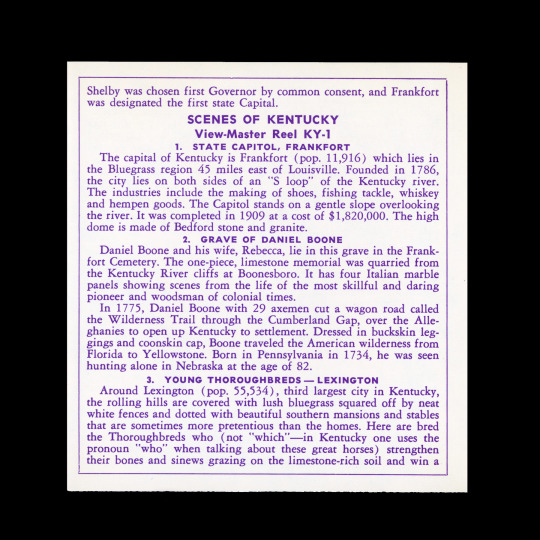
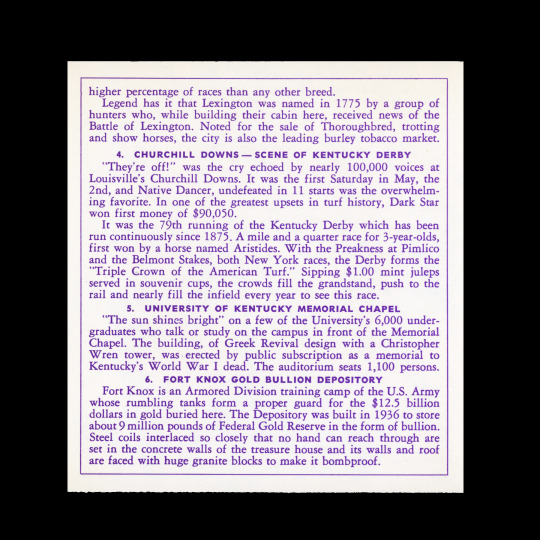
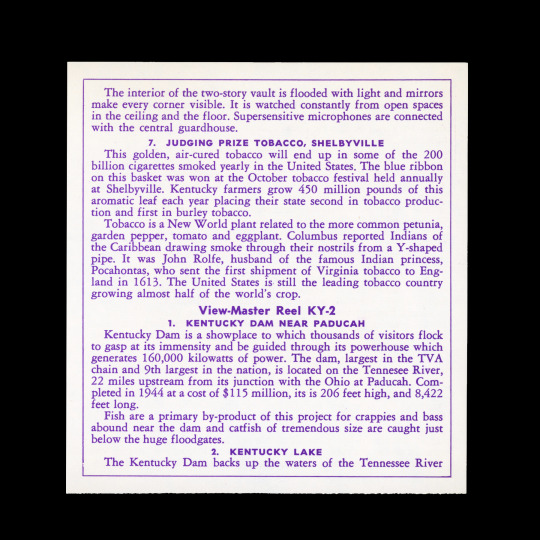


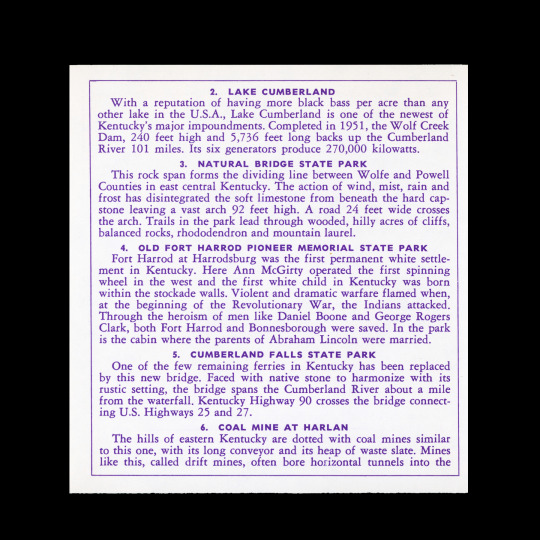

Brand: View-Master
Packet Title: Kentucky
Booklet Title: Kentucky
Booklet Subtitle: The Bluegrass State
Date: 1955
Note: When reading the booklet descriptions, please remember that these booklets are old (most are 65+ years old) and the information and history presented in them as factual may be inaccurate, outdated, and in some cases, offensive.
Booklet Introduction Description:
Kentuckians are justifiably proud of their state. The modest ones will quote the words of a small-town Kentucky preacher who said, "Kentucky is a Heaven of a place." Others go so far as to say that Heaven is a "Kentucky of a place."
It is the land of the Kentucky Colonel with his frosty mint julep, of Daniel Boone looking out at a wilderness paradise from the Cumberland Gap, of the Kentucky Derby and the fleet Thoroughbreds, of golden burley tobacco and Harlan County coal, of the birthplace of two presidents who went to war against each other -- Abraham Lincoln and Jefferson Davis, of Uranium 235 at Paducah, gold at Fort Knox, and bourbon whiskey at Lexington and Louisville.
KENTUCKY FACTS AND FIGURES
Kentucky is called The Bluegrass State because the grass that covers the rolling plains of central Kentucky has tiny dusty blue blossoms. The State Flower is the Goldenrod; the Bird the Cardinal; the Tree is the Tulip Tree; the Motto is "United We Stand, Divided We Fall";
and the Song is Stephen Foster's "My Old Kentucky Home."
The state whose farmers cleared the land to plant tobacco is the second largest tobacco growing state, and leads in burley tobacco. Tobacco is the leading crop bringing $175 million annually to farmers with corn second at $160 million. Most of the corn is turned into whiskey to the tune of $200 million per year.
The leading mineral is coal, the state ranking third in the nation. Natural gas and gasoline are important products and about one-fourth of the nation's fluorspar is mined in Kentucky.
Lexington is the world's largest loose-leaf tobacco market. The state is also famous for its hickory-smoked and sugar-cured hams.
Half of all the big horseraces in the United States are won by Kentucky-bred horses. The Bluegrass State has raised such famous horses as Man O' War, Lexington, War Admiral, Equipoise, Sea Biscuit, Whirlaway, and Count Fleet.
THE STATE AND ITS PEOPLE
Kentucky has an area of 40,395 square miles--36th in size among the states. It lies between the Alleghany Mountains and the Ohio River and is bounded by Indiana and Ohio on the north; West Virginia and Virginia on the east; Tennessee on the south; and Missouri and Illinois on the west. The Ohio River forms its entire north and northwest border and the Mississippi is part of its western border.
The highest elevation in the state is Big Black Mountain (alt. 4,150) in Harlan County, the lowest (alt. 257) along the Mississippi.
The state has a population of 2,944,806 (1950), ranking 19th among the states. Over 60% of the population is rural.
Kentucky was a hunting ground and war ground for many tribes of Indians but home for none when the first settlers came. These white men were Scotch, English, Irish and German. Many of their descendants in the eastern hills still speak an Elizabethan English that sounds like passages from the King James Bible.
Many famous people were born in Kentucky or called it home: Abraham Lincoln; Jefferson Davis; Daniel Boone; Irvin S. Cobb, the humorist of Paducah; Kit Carson, Indian scout and frontiersman born in Madison County; Henry Clay, the statesman whose home was in Lexington; D. W. Griffith, producer of the first great motion picture, Birth of a Nation, was born at La Grange; Carrie Nation, the hatchet-wielding temperance agitator was born in Kentucky, land of good bourbon whiskey; Zachary Taylor, our 12th president, grew up and is buried not far from Louisville; and even the storied Hatfields and McCoys really lived and feuded in the hills of Kentucky.
HIGHLIGHTS OF HISTORY
The Kentucky country, for a long time, was the unexplored part of the Virginia colony. A lively curiosity sent land companies from Virginia and North Carolina into the new area. However, the first house was not built until Dr. Thomas Walker, in 1750, explored the Big Sandy River area establishing a base near Barbourville.
Daniel Boone, with a group of hunters, entered the Kentucky Valley in 1767 where he met the famous Long Hunters. These were adventurous white men whose extended hunting trips took them over the mountains from North Carolina.
The first permanent settlement was established by James Harrod and a company of adventurers from Pennsylvania at Harrodsburg in 1774. In 1776, Kentucky was organized as a Virginia county.
In 1780, George Rogers Clark, whose younger brother was the co-leader of the Lewis & Clark Expedition, led 3,000 settlers down the Ohio from Maysville to Louisville. In "broadhorn" boats that looked like an adaptation of Noah's Ark, the settlers ran a gauntlet as Indians lay in ambush on the Kentucky shore and showered the boats with a rain of deadly arrows.
Kentucky became the 15th star in the American Flag in 1792. Isaac Shelby was chosen first Governor by common consent, and Frankfort was designated the first state Capital.
1 note
·
View note
Text
Events 2.8
421 – Constantius III becomes co-Emperor of the Western Roman Empire.
1238 – The Mongols burn the Russian city of Vladimir.
1250 – Seventh Crusade: Crusaders engage Ayyubid forces in the Battle of Al Mansurah.
1347 – The Byzantine civil war of 1341–47 ends with a power-sharing agreement between John VI Kantakouzenos and John V Palaiologos.
1575 – Leiden University is founded, and given the motto Praesidium Libertatis.
1587 – Mary, Queen of Scots, is executed on suspicion of having been involved in the Babington Plot to murder her cousin, Queen Elizabeth I.
1590 – Luis de Carvajal y de la Cueva is tortured by the Inquisition in Mexico, charged with concealing the practice of Judaism of his sister and her children.
1601 – Robert Devereux, 2nd Earl of Essex, rebels against Queen Elizabeth I and the revolt is quickly crushed.
1693 – The College of William & Mary in Williamsburg, Virginia, America, is granted a charter by King William III and Queen Mary II.
1807 – After two days of bitter fighting, the Russians under Bennigsen and the Prussians under L'Estocq concede the Battle of Eylau to Napoleon.
1817 – Las Heras completes his crossing of the Andes with an army to join San Martín and liberate Chile from Spain.
1837 – Richard Johnson becomes the first Vice President of the United States chosen by the United States Senate.
1865 – Delaware refuses to ratify the Thirteenth Amendment to the U.S. Constitution. Slavery was outlawed in the United States, including Delaware, when the Amendment was ratified by the requisite number of states on December 6, 1865. Delaware ratified the Thirteenth Amendment on February 12, 1901, which was the ninety-second anniversary of the birth of Abraham Lincoln.
1879 – Sandford Fleming first proposes adoption of Universal Standard Time at a meeting of the Royal Canadian Institute.
1879 – The England cricket team led by Lord Harris is attacked in a riot during a match in Sydney.
1885 – The first government-approved Japanese immigrants arrive in Hawaii.
1887 – The Dawes Act authorizes the President of the United States to survey Native American tribal land and divide it into individual allotments.
1904 – Battle of Port Arthur: A surprise torpedo attack by the Japanese at Port Arthur, Japan starts the Russo-Japanese War.
1904 – Aceh War: Dutch Colonial Army's Marechaussee regiment led by General G.C.E. van Daalen launch military campaign to capture Gayo Highland, Alas Highland, and Batak Highland in Dutch East Indies' Northern Sumatra region, which ends with genocide to Acehnese and Bataks people.
1910 – The Boy Scouts of America is incorporated by William D. Boyce.
1915 – D. W. Griffith's controversial film The Birth of a Nation premieres in Los Angeles.
1922 – United States President Warren G. Harding introduces the first radio set in the White House.
1924 – Capital punishment: The first state execution in the United States by gas chamber takes place in Nevada.
1937 – Spanish Civil War: Republicans establish the Interprovincial Council of Santander, Palencia and Burgos in Cantabria.
1942 – World War II: Japan invades Singapore.
1942 – World War II: Dutch Colonial Army General Destruction Unit (AVC, Algemene Vernielings Corps) burns Banjarmasin, South Borneo to avoid Japanese capture.
1945 – World War II: The United Kingdom and Canada commence Operation Veritable to occupy the west bank of the Rhine.
1945 – World War II: Mikhail Devyataev escapes with nine other Soviet inmates from a Nazi concentration camp in Peenemünde on the island of Usedom by hijacking the camp commandant's Heinkel He 111.
1946 – The first portion of the Revised Standard Version of the Bible, the first serious challenge to the popularity of the Authorized King James Version, is published.
1946 – The People's Republic of Korea is dissolved in the North, establishing the communist-controlled Provisional People's Committee of North Korea.
1950 – Cold War: The Stasi, the secret police of East Germany, is established.
1955 – The Government of Sindh, Pakistan, abolishes the Jagirdari system in the province. One million acres (4,000 km2) of land thus acquired is to be distributed among the landless peasants.
1960 – Queen Elizabeth II of the United Kingdom issues an Order-in-Council, stating that she and her family would be known as the House of Windsor, and that her descendants will take the name Mountbatten-Windsor.
1960 – The Hollywood Walk of Fame is established.
1962 – Charonne massacre: Nine trade unionists are killed by French police at the instigation of Nazi collaborator Maurice Papon, then chief of the Paris Prefecture of Police.
1963 – The regime of Prime Minister of Iraq, Brigadier General Abd al-Karim Qasim is overthrown by the Ba'ath Party.
1965 – Eastern Air Lines Flight 663 crashes into the Atlantic Ocean and explodes, killing everyone aboard.
1968 – American civil rights movement: The Orangeburg massacre: An attack on black students from South Carolina State University who are protesting racial segregation at the town's only bowling alley, leaves three or four dead in Orangeburg, South Carolina.
1971 – The NASDAQ stock market index opens for the first time.
1971 – South Vietnamese ground troops launch an incursion into Laos to try to cut off the Ho Chi Minh trail and stop communist infiltration.
1974 – After 84 days in space, the crew of Skylab 4, the last crew to visit American space station Skylab, returns to Earth.
1978 – Proceedings of the United States Senate are broadcast on radio for the first time.
1981 – Twenty-one association football spectators are trampled to death at Karaiskakis Stadium in Neo Faliro, Greece, after a football match between Olympiacos F.C. and AEK Athens F.C.
1983 – The Melbourne dust storm hits Australia's second largest city. The result of the worst drought on record and a day of severe weather conditions, a 320 metres (1,050 ft) deep dust cloud envelops the city, turning day to night.
1983 – Irish race horse Shergar is stolen by gunmen.
1986 – Hinton train collision: Twenty-three people are killed when a VIA Rail passenger train collides with a 118-car Canadian National freight train near the town of Hinton, Alberta, west of Edmonton. It is the worst rail accident in Canada until the Lac-Mégantic, Quebec derailment in 2013 which killed forty-seven people.
1989 – Independent Air Flight 1851 strikes Pico Alto mountain while on approach to Santa Maria Airport (Azores) killing all 144 passengers on board.
1993 – General Motors sues NBC after Dateline NBC allegedly rigs two crashes intended to demonstrate that some GM pickups can easily catch fire if hit in certain places. NBC settles the lawsuit the next day.
1993 – An Iran Air Tours Tupolev Tu-154 and an Iranian Air Force Sukhoi Su-24 collide in mid-air near Qods, Iran, killing all 133 people on board both aircraft.
1996 – The U.S. Congress passes the Communications Decency Act.
2005 – Sri Lankan Civil War: Sri Lankan Tamil politician and former MP A. Chandranehru dies of injuries sustained in an ambush the previous day.
2010 – A freak storm in the Hindu Kush mountains of Afghanistan triggers a series of at least 36 avalanches, burying over 2 miles (3.2 km) of road, killing at least 172 people and trapping over 2,000 travelers.
2013 – A blizzard disrupts transportation and leaves hundreds of thousands of people without electricity in the Northeastern United States and parts of Canada.
2014 – A hotel fire in Medina, Saudi Arabia kills 15 Egyptian pilgrims with 130 others injured.
0 notes
Photo

“Admits Stealing Twenty Dresses,” Kingston Whig-Standard. October 25, 1932. Page 5.
----
Claude Griffin of Gananoque Sentenced to Ontario Reformatory
-----
Gananoque, Oct. 24 —Claude Griffin, a local man who surrendered himself to Chief Constable William Chevis on Saturday evening and admitted the theft of twenty dresses valued at $142, which were consigned to Pattenick's store, from A. Nuttall’s transport truck on February 4th, was tried before Magistrate James H. Sampson yesterday afternoon and sentenced to twelve months determinate and twelve months indeterminate in the Ontario Reformatory.
The accused elected to be tried by the magistrate and Crown Attorney Atkinson of Brockvllle, who conducted the prosecution, called A. A. Nuttall, owner of the transport truck from which the foods were taken, as the first witness. Mr. Nultall testified that the accused was with him on the date In question and that a number of parcels had been picked up at Pattenick's Cobourg store for delivery at the Gananoque branch. Arriving in Gananoque at about 1 a.m., witness had placed the truck in his garage and Griffin had come next day to deliver the parcels around town. He had taken the truck out for about an hour and a half and returned with the parcels apparently all delivered. However,on the following Saturday, Nuttall had been advised that one of the four parcels consigned to Pattenick's was missing. He had questioned Griffith about the shortage, but the accused had claimed he knew nothing about it. Witness had then notified the insurance company of the loan and they had settled the claim for the amount at which the parcel was valued $142.
The next witness was Robert Leavis, manager of Pattenick's local store, who recalled that the shipment was short the dresses on the date in question but did not remember the number of packages received at the time or the value of the dresses.
W. A. Peck, local insurance agent, testified as to the policy covering the loss of the goods and the payment of the claim.
The last witness was Chief Chavis, who told how Griffin had given himself up on the comer of Stone and King streets on Saturday evening.
“Are you still looking for the parcel of goods taken from Nuttall's truck last February?" accused had asked.
"Yes," replied the Chief. '‘Well," said Griffin, 'I'm the man that took it.”
The Chief and Griffin had then gone to the former's office where a voluntary statement had been taken. Accused had been warned that he did not have to make the statement and that it might be used against him. The statement was to the effect that he had stolen the parcel of clothing from Nuttall's truck and disposed of the articles to various people.
“Did you question him as to the disposition of the goods?" asked the Crown.
"Yes,” replied the Chief "and he said he had sold them but to whom he did not remember now.”
In summing up the case, the Crown pointed out that the amount involved was considerable. On the other hand, the accused had given himself up and that must be taken into consideration. In passing sentence, the magistrate pointed out to Griffith that if he behaved himself in the reformatory during his stay there, he would not be required to serve the second twelve months of his sentence but would be allowed out on probation.
Griffin, who is an expert driver, drove the car containing himself and Chief Chevis to the county jail at Brockville. He also drove the car to Gananoque from Brockville earlier in the afternoon for his trial.
#gananoque#brockville#stealing parcels#stealing from the boss#theft#turning yourself in#petty theft#selling stolen goods#first time offender#sentenced to prison#guelph reformatory#great depression in canada#history of crime and punishment#crime and punishment in canada
1 note
·
View note
Text
One Day Guide to Spend in Glendale, California
If you're looking for a day trip that's near Los Angeles, but without all the hustle and bustle, consider spending a day in Glendale, CA. This city boasts museums, outdoor spaces and more—all within walking distance from one another. Here are some of our favorite spots to visit on your next trip!
Glendale Galleria
Glendale Galleria is located at 100 West Broadway, Glendale, CA 91210.
The mall is open daily from 10 a.m. to 9 p.m., except on Thanksgiving and Christmas when they are closed.
The cost of admission per person is $2 with your First Fridays Pass or $5 without one. If you're unsure whether you have a pass or not, ask at the gate!

There are many activities to enjoy at the Galleria: visit Santa's Workshop (free all month), see an ice sculptor in action ($5 per person), ride in a horse-drawn carriage ($15 for five minutes), shop for gifts at Macy's and other stores, dine with friends at one of several restaurants that line the walkways—and more! Here's a complete list of things you can do here!
Museum of Neon Art
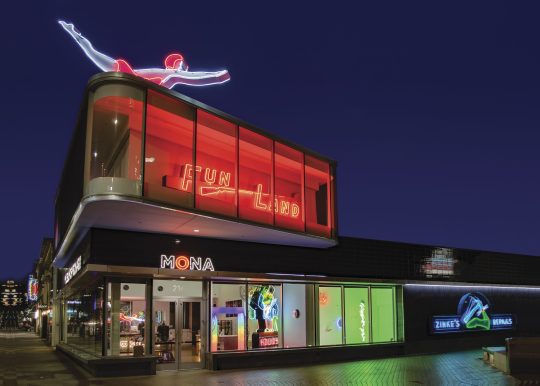
Museum of Neon Art is small but mighty, with a collection of neon art from artists around the world. It’s open daily, and admission is free. Kids and adults alike will enjoy this place, with its classic signs and colorful displays that are sure to inspire plenty of photos. Located right in downtown Glendale, it’s a great stop on your way out of or into town!
Moonlight Rollerway, Inc

The Moonlight Rollerway, Inc is a roller skating rink located in the Glendale Galleria. This rink is open year-round and it's open until 10pm on weekdays and 11pm on weekends. Prices range from $7-$13 per person.
The Moonlight Rollerway, Inc offers great deals for special events like their Thursday Night Specials! Get two hours of skate time for only $10! It's perfect for birthday parties or just a night out with friends!
Autry Museum of the American West

The Autry Museum of the American West is a museum in Los Angeles, California, dedicated to the celebration of the diverse people and cultures of the American West. It is located in Griffith Park, near the Los Angeles Zoo.
The museum was founded by Gene Autry. He originally wanted to create it as an arena for all things Western: rodeo events and concerts, horse shows and other competitions. But after he saw some artifacts from his own collection being auctioned off at Sotheby's, he decided that instead of selling them off for money he would create a permanent home where people could enjoy them for free!
Fremont Park
Fremont Park is a park located in the city of Glendale, California. It is the largest park in Glendale, covering an area of approximately 19 acres (77,000 m2). The park's boundaries are Lake Street to the west, Brand Boulevard to the south and east, and Beverly Boulevard to the north.
The park was created during the 1930s depression by James W. Mackey and his son-in-law George A. Hormel (of Hormel Foods) as part of their long-term vision for a large public space that would serve as central plaza for all residents of Glendale.[1] The land was purchased from several landowners including Caroline Atherton Smith (through her estate), who also owned much of modern day downtown Glendale.
Glendale is a great city to spend the day exploring. You can get around simply by walking, or you can go for a ride on the Red Line Metro bus. There are so many things to do in Glendale that it’s impossible to list them all here! The best way would be just go and have fun out there!"
Davtyan Law Firm, Inc. is a Los Angeles employment lawyer that provides legal services to clients throughout California. Our firm specializes in litigating cases involving employee rights, discrimination, harassment and retaliation. The firm also handles cases involving wage and hour violations, wrongful termination, and other workplace issues.

We are dedicated to helping employees who have been wronged by their employers or former employers recover the compensation they deserve. We offer free consultations so you can learn more about your legal options before deciding whether you need to hire an attorney.
Davtyan Law Firm, Inc.
880 E Broadway, Glendale, CA 91205
18552053681
https://www.davtyanlaw.com/
https://www.google.com/maps?cid=1030395778475401248
youtube
#los angeles employment lawyer#los angeles wrongful termination attorney#Employment lawyer#employment attorney#Employment lawyer California#employment attorney glendale ca
0 notes
Photo

'A Solitary World’
source
47 notes
·
View notes
Text
Here are the US representatives who voted against the US pro-LGBT+ Equality Act
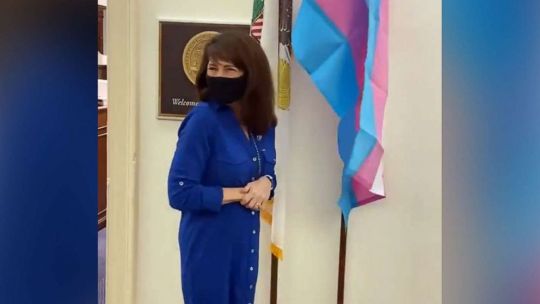
The US Equality Act is to outlaw discrimination against LGBTQ people in housing, credit, jury service, public accommodations, and federal funding.
The House of Representatives passed the legislation yesterday, but it is unlikely that the Senate will follow up, given the Republican Party's increasing hostility to queer people. They are currently weaponizing transphobia in an attempt at mobilizing their base.
In the Senate the bill will require at least 10 Republicans to vote with all Democrats to advance past the so-called filibuster.
Metro Weekly has listed the representatives that voted against the law in the House.
Photo of Rep. Marie Newman.
Alabama:
Robert Aderholt
Mo Brooks
Jerry Carl
Barry Moore
Gary Palmer
Mike Rogers
Alaska:
Don Young
Arizona:
Andy Biggs
Paul A. Gosar
Debbie Lesko
David Schweikert
Arkansas:
Rick Crawford
French Hill
Bruce Westerman
Steve Womack
California:
Ken Calvert
Darrell Issa
Mike Garcia
Young Kim
Doug LaMalfa
Kevin McCarthy
Tom McClintock
Devin Nunes
Jay Obernolte
Michelle Steel
David G. Valadao
Colorado:
Lauren Boebert
Ken Buck
Doug Lamborn
Florida:
Gus M. Bilirakis
Vern Buchanan
Kat Cammack
Mario Diaz-Balart
Byron Donalds
Neal Dunn
C. Scott Franklin
Matt Gaetz
Carlos A. Gimenez
Brian Mast
Bill Posey
John Rutherford
Maria Elvira Salazar
W. Gregory Steube
Michael Waltz
Daniel Webster
Georgia:
Rick Allen
Buddy Carter
Andrew S. Clyde
A. Drew Ferguson
Marjorie Taylor Greene
Jody Hice
Barry Loudermilk
Austin Scott
David Scott
Idaho:
Russ Fulcher
Mike Simpson
Illinois:
Mike Bost
Rodney Davis
Darin LaHood
Adam Kinzinger
Mary E. Miller
Indiana:
Jim Banks
James Baird
Larry Bucshon
Trey Hollingsworth
Greg Pence
Victoria Spartz
Jackie Walorski
Iowa:
Randy Feenstra
Ashley Hinson
Mariannette Miller-Meeks
Kansas:
Ron Estes
Jake LaTurner
Tracey Mann
Kentucky:
Andy Barr
James Comer
S. Brett Guthrie
Thomas Massie
Harold Rogers
Louisiana:
Clay Higgins
Garret Graves
Mike Johnson
Steve Scalise
Maryland:
Andy Harris
Michigan:
Jack Bergman
Bill Huizenga
Lisa C. McClain
Peter Meijer
John Moolenaar
Fred Upton
Tim Walberg
Minnesota:
Tom Emmer
Michelle Fischbach
Jim Hagedorn
Pete Stauber
Mississippi:
Michael Guest
Trent Kelly
Steven Palazzo
Missouri:
Sam Graves
Vicky Hartzler
Billy Long
Blaine Luetkemeyer
Jason Smith
Ann Wagner
Montana:
Matthew M. Rosendale
Nebraska:
Don Bacon
Jeff Fortenberry
Adrian Smith
Nevada:
Mark Amodei
New Jersey:
Chris Smith
Jefferson Van Drew
New Mexico:
Yvette Herrell
New York:
Andrew R. Garbarino
Chris Jacobs
Nicole Malliotakis
Elise Stefanik
Claudia Tenney
Lee Zeldin
North Carolina:
Dan Bishop
Ted Budd
Madison Cawthorn
Gregory Francis Murphy
Virginia Foxx
Richard Hudson
Patrick T. McHenry
David Rouzer
North Dakota:
Kelly Armstrong
Ohio:
Troy Balderson
Steve Chabot
Warren Davidson
Bob Gibbs
Anthony Gonzalez
Jim Jordan
Bill Johnson
David Joyce
Robert E. Latta
Steve Stivers
Michael Turner
Brad Wenstrup
Oklahoma:
Stephanie I. Bice
Tom Cole
Kevin Hern
Frank Lucas
Markwayne Mullin
Oregon:
Cliff Bentz
Pennsylvania:
John Joyce
Mike Kelly
Daniel Meuser
Scott Perry
Guy Reschenthaler
Lloyd Smucker
Glenn Thompson
South Carolina:
Jeff Duncan
Nancy Mace
Ralph Norman
Tom Rice
William Timmons
Joe Wilson
South Dakota:
Dusty Johnson
Tennessee:
Timm Burchett
Scott DesJarlais
Chuck Fleischmann
Mark Green
Diana Harshbarger
David Kustoff
John W. Rose
Texas:
Jodey Arrington
Brian Babin
Kevin Bady
Michael Burgess
John Carter
Michael Cloud
Dan Crenshaw
Pat Fallon
Louie Gohmert
Tony Gonzales
Lance Gooden
Kay Granger
Ronny Jackson
Michael T. McCaul
Troy E. Nehls
August Pfluger
Chip Roy
Pete Sessions
Van Taylor
Beth Van Duyne
Randy Weber
Roger Williams
Utah:
John R. Curtis
Blake D. Moore
Burgess Owens
Christ Stewart
Virginia:
Ben Cline
Bob Good
Morgan Griffith
Robert J. Wittman
Washington:
Jaime Herrera Beutler
Cathy McMorris Rodgers
Dan Newhous
West Virginia:
David McKinley
Carol Miller
Alex Mooney
Wisconsin:
Scott Fitzgerald
Mike Gallagher
Glenn Grothman
Bryan Steil
Thomas P. Tiffany
Wyoming:
Liz Cheney
All Democrats voted for the legislation, as did three Republicans.
#lgbt#lgbtqa#trans#bisexual#lesbian#gay#lgbtqi#lgbt+#equality act#republican party#homophobia#transphobia
573 notes
·
View notes
